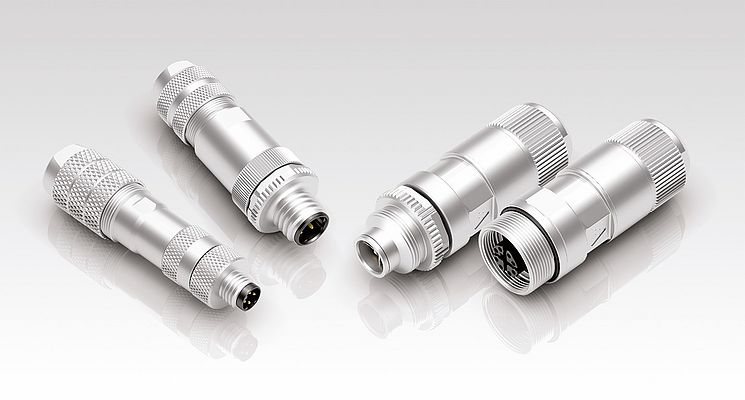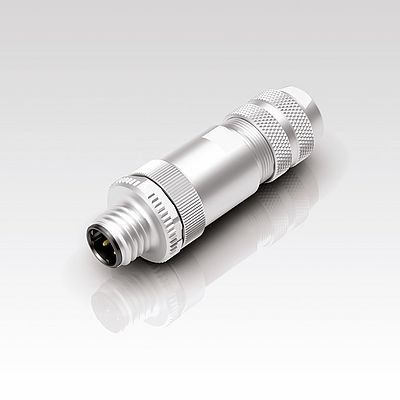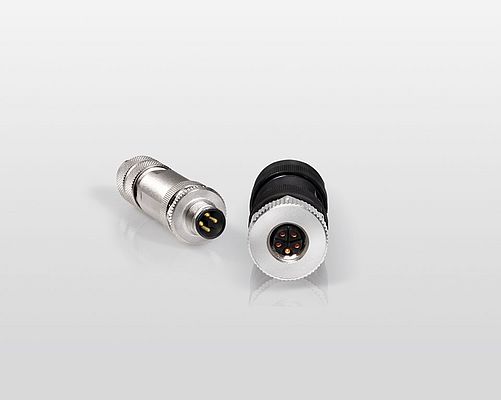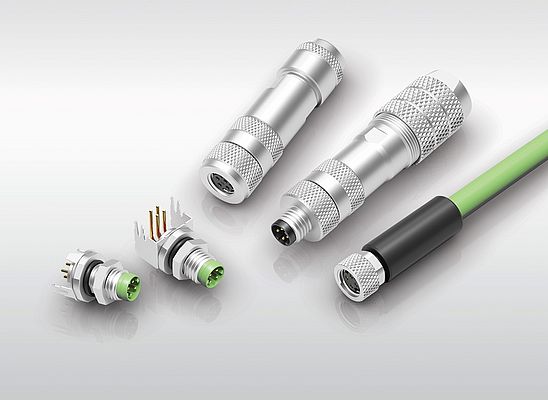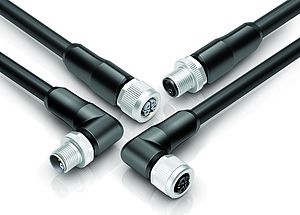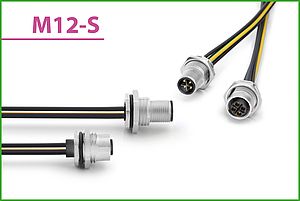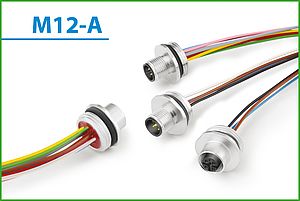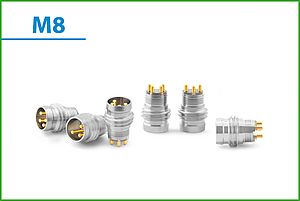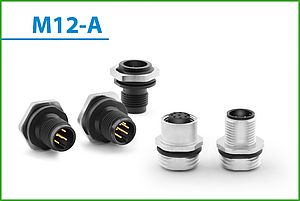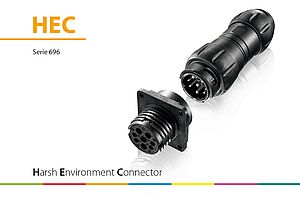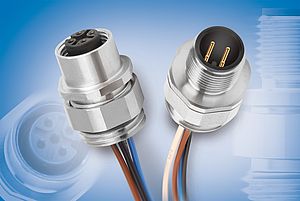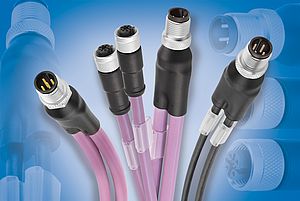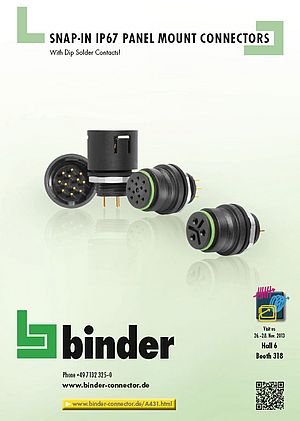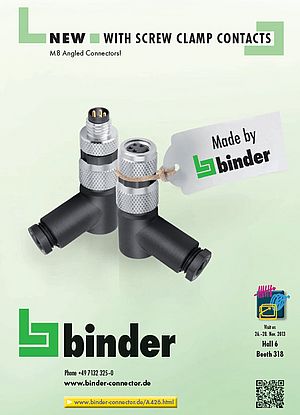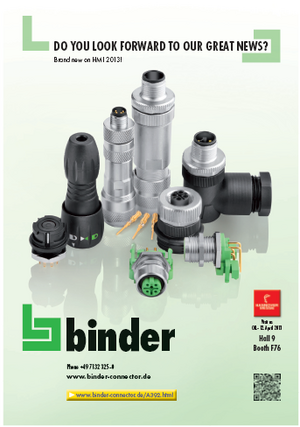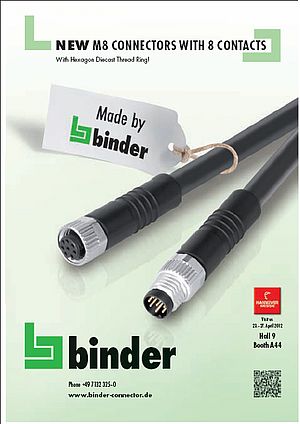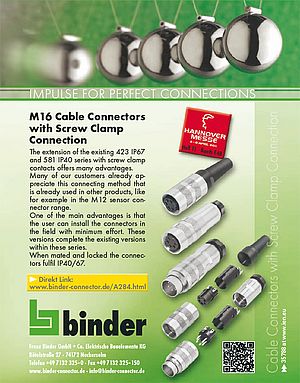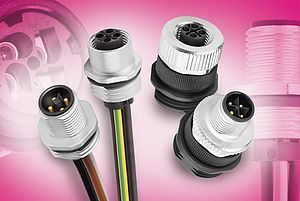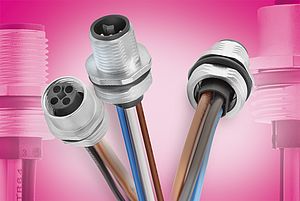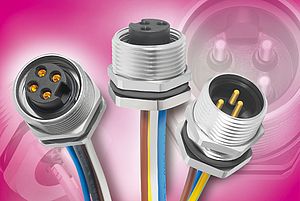Binder. Digitization and the networking of cyber-physical systems (CPS) is currently one of the dominating trends in automation technology. The goal is flexible and highly customizable production, which should achieve an unprecedented level of variant diversity and productivity across industries. Here, at the physical level, robust and high-performance interconnect solutions play a key role. Their task is no longer limited to signal transmission between modules or devices: more and more often, high-bandwidth data transfer is in demand. Many scenarios also require power to be supplied to the connected components. In addition to safe and reliable function, users are increasingly focusing on performance features such as real-time capability and signal integrity.
Basic components of decentralized automation
The digital transformation in automation technology – as part of Industry 4.0 – is already having a massive impact on the need for industrial-grade connection technology. It is also defining the future, expanded requirements for all automation components. One of the key features of this transformation is the merging of the physical and IT worlds within the aforementioned CPS. These represent a new type of factory automation concept that is evolving from strictly hierarchical to decentralized, modular and self-organizing architectures.
The traditional rigid structure of automated plants is thus increasingly giving way to a highly flexible interaction of modules: Industrial IoT devices such as networking-capable sensors, actuators, controllers, embedded computers, and software. One of the new challenges of automation is to integrate all these components into the manufacturing processes in a way that is as variable as possible, configurable at any time, and yet efficient. For the user, it is essential to find advantageous solutions in terms of time, costs and space requirements.
With regard to connection technology, this decentralized concept results in a rapidly growing number of interfaces that must be served with high-performance and reliable products. Circular connectors in sizes M8, M12 and M16 are proving their significance here as basic Industry-4.0 components (Fig. 1). They are optimized for the decisive operating conditions, especially with regard to the above-mentioned economic aspects. Available as cable assemblies or freely configurable, equipped with proven termination and locking technologies and designed for industry-relevant protection degrees, they ensure the signal and data connection and, if required, the power supply of the automation components under the requirements of Industry 4.0.
Designed for factory and process conditions
In the context of Industry 4.0, industrial environments such as production or process plants define the requirements for the robustness of connection technology: protection against dust, humidity, and physical contact, for example according to IP67 to IP69K, is a fundamental criterion; so is resistance to shocks and vibrations. Protection against radiation or the electromagnetic noise of a factory floor is also important, as are specifications for industrial operating temperatures as well as overvoltages and overcurrents. Due to their design, circular connectors can score points under these application conditions. The protection degree and mechanical stability of the connection are supported by the proven screw-locking system (Fig. 2).
With regard to electromagnetic interference, circular connectors with metal housings are advantageous. To achieve 360° shielding, the cable shielding must be sufficiently coupled to the conductive housing of the connector. When mated, the plug and socket are securely galvanically connected, and the permanent coupling of the socket housing, for example to a conductive panel, can be easily implemented by the user.
As a result of the variability and modularization of industrial processes described above, robust connection solutions must endure a growing number of mating cycles. The mechanical resilience of the contacts is primarily a question of materials technology. The contact material and the composition and thickness of the contact coating are decisive here. For 100 and more mating cycles, for example, thick gold-plated contacts made of suitable materials such as beryllium copper are recommended. Fig. 3 shows an example product.
Ethernet, data analysis, and miniaturization
High-bandwidth Ethernet connectivity is a cornerstone of Industry 4.0. In future, it will link the field level of automation with the company's data infrastructure and an – if necessary external – cloud. High-bandwidth Ethernet creates consistency in communication protocols across the levels of the classic automation pyramid and enables, for example, the real-time acquisition and analysis of data from field devices such as sensors, but also power supplies. If, for example, network component data such as load profiles, temperature development or the quality of the mains voltage can be evaluated in real time, plant operators can use these analyses to optimize process parameters, avoid overload situations or identify maintenance requirements at an early stage. This is an important prerequisite for reducing downtimes in machines and plants and lowering operating costs.
Applications like these are driving the miniaturization of connectivity components. The M8 circular connector, which in the past was reserved solely for signal transmission, has therefore evolved into a solution for data communication under particularly constrained space conditions. M8 connectors with D coding enable users to integrate field devices with data rates of up to 100 Mbit/s into Ethernet networks. In addition, thanks to PoE or PoE-plus functionality (Power-over-Ethernet), they enable power to be supplied to the connected devices. In view of their application environment in factory or process automation, these products are also equipped with secure locking and designed to meet the industry-relevant protection degrees (Fig. 4).
Future potential: SPE and Ethernet APL
Lightweight, thin cables, high bandwidth, flexible installation with reduced effort: Single-Pair Ethernet (SPE) is a technology that promises users continuous TCP/IP data communication from the field-level sensor to the cloud. This is because, unlike fieldbuses, Ethernet penetrates all levels of automation. Field devices can be connected via SPE at data rates of up to 1 Gbit/s across applications using just one twisted pair - instead of the previous two or four, depending on the bandwidth required. Thanks to PoDL (Power over Data Line) compatibility, the same twisted pair can be used to supply power to the relevant field components. Sensors, actuators, and other instruments can be integrated into existing Ethernet installations without interfaces and protocol converters - in factory as well as in process and building automation.
In the field of process automation, Ethernet cabling is facing an extended requirements profile: In addition to high data rates and the robustness criteria of a factory floor, the range of communication matters; furthermore, devices must feature the intrinsic safety property that enables them to be used in potentially explosive environments. The Ethernet Advanced Physical Layer (APL) defines a physical transmission layer for Ethernet communication at 10 Mbit/s and power supply via a twisted pair at distances of up to 1,000 m. As a special form of SPE, Ethernet APL is also suitable for end-to-end and cross-application field instrumentation.
The consistency of the communication protocols from the operating to the field level enables users to access not only process data but also device data – for example, from the self-diagnostics of intelligent power supplies, as shown above – in real time. Production planning, process control and data analysis in real time are thus within reach. Technology experts like binder Product Manager Dieter Sandula follow trends like these very closely: on the one hand, in order to incorporate their insight into new product generations for the benefit of customers; on the other hand, in order to support binder customers in their projects as competent advisors.
Summary
Connectors are key components of Industry 4.0. In the course of the digital transformation in automation, the demand for connectivity solutions suitable for industrial use is growing rapidly. At the same time, however, the requirements placed on the products are increasing (Fig. 5): particularly with regard to communication bandwidth, integration density, and signal integrity under production or process conditions. binder offers seven circular connector product series in this segment in the M8, M12 and M16 form factors, which can be configured by the customers depending on their specific applications.



